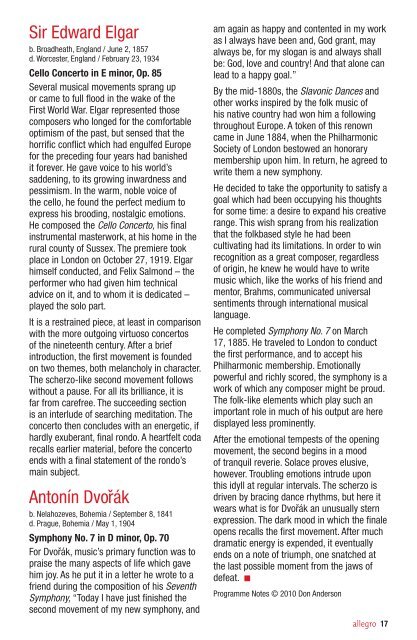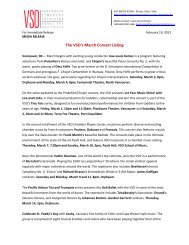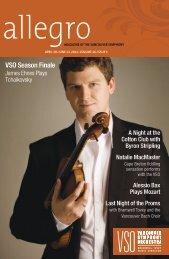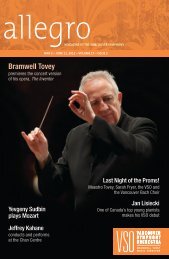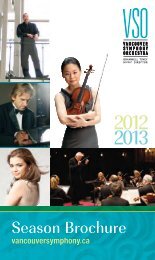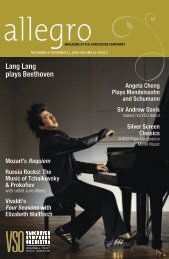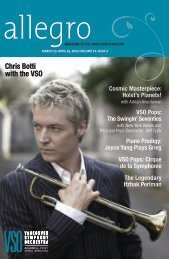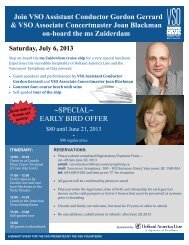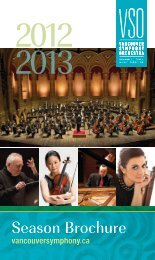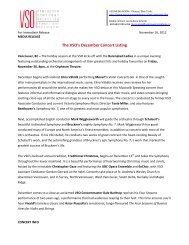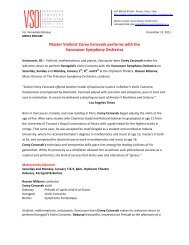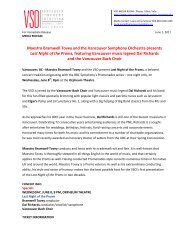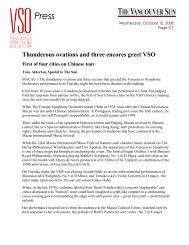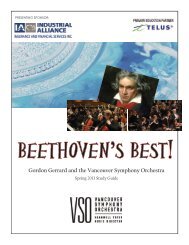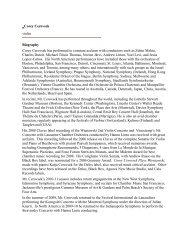issue one - Vancouver Symphony Orchestra
issue one - Vancouver Symphony Orchestra
issue one - Vancouver Symphony Orchestra
You also want an ePaper? Increase the reach of your titles
YUMPU automatically turns print PDFs into web optimized ePapers that Google loves.
Sir Edward Elgar<br />
b. Broadheath, England / June 2, 1857<br />
d. Worcester, England / February 23, 1934<br />
Cello Concerto in E minor, Op. 85<br />
Several musical movements sprang up<br />
or came to full flood in the wake of the<br />
First World War. Elgar represented those<br />
composers who longed for the comfortable<br />
optimism of the past, but sensed that the<br />
horrific conflict which had engulfed Europe<br />
for the preceding four years had banished<br />
it forever. He gave voice to his world’s<br />
saddening, to its growing inwardness and<br />
pessimism. In the warm, noble voice of<br />
the cello, he found the perfect medium to<br />
express his brooding, nostalgic emotions.<br />
He composed the Cello Concerto, his final<br />
instrumental masterwork, at his home in the<br />
rural county of Sussex. The premiere took<br />
place in London on October 27, 1919. Elgar<br />
himself conducted, and Felix Salmond – the<br />
performer who had given him technical<br />
advice on it, and to whom it is dedicated –<br />
played the solo part.<br />
It is a restrained piece, at least in comparison<br />
with the more outgoing virtuoso concertos<br />
of the nineteenth century. After a brief<br />
introduction, the first movement is founded<br />
on two themes, both melancholy in character.<br />
The scherzo-like second movement follows<br />
without a pause. For all its brilliance, it is<br />
far from carefree. The succeeding section<br />
is an interlude of searching meditation. The<br />
concerto then concludes with an energetic, if<br />
hardly exuberant, final rondo. A heartfelt coda<br />
recalls earlier material, before the concerto<br />
ends with a final statement of the rondo’s<br />
main subject.<br />
Antonín Dvořák<br />
b. Nelahozeves, Bohemia / September 8, 1841<br />
d. Prague, Bohemia / May 1, 1904<br />
<strong>Symphony</strong> No. 7 in D minor, Op. 70<br />
For Dvořák, music’s primary function was to<br />
praise the many aspects of life which gave<br />
him joy. As he put it in a letter he wrote to a<br />
friend during the composition of his Seventh<br />
<strong>Symphony</strong>, “Today I have just finished the<br />
second movement of my new symphony, and<br />
am again as happy and contented in my work<br />
as I always have been and, God grant, may<br />
always be, for my slogan is and always shall<br />
be: God, love and country! And that al<strong>one</strong> can<br />
lead to a happy goal.”<br />
By the mid-1880s, the Slavonic Dances and<br />
other works inspired by the folk music of<br />
his native country had won him a following<br />
throughout Europe. A token of this renown<br />
came in June 1884, when the Philharmonic<br />
Society of London bestowed an honorary<br />
membership upon him. In return, he agreed to<br />
write them a new symphony.<br />
He decided to take the opportunity to satisfy a<br />
goal which had been occupying his thoughts<br />
for some time: a desire to expand his creative<br />
range. This wish sprang from his realization<br />
that the folkbased style he had been<br />
cultivating had its limitations. In order to win<br />
recognition as a great composer, regardless<br />
of origin, he knew he would have to write<br />
music which, like the works of his friend and<br />
mentor, Brahms, communicated universal<br />
sentiments through international musical<br />
language.<br />
He completed <strong>Symphony</strong> No. 7 on March<br />
17, 1885. He traveled to London to conduct<br />
the first performance, and to accept his<br />
Philharmonic membership. Emotionally<br />
powerful and richly scored, the symphony is a<br />
work of which any composer might be proud.<br />
The folk-like elements which play such an<br />
important role in much of his output are here<br />
displayed less prominently.<br />
After the emotional tempests of the opening<br />
movement, the second begins in a mood<br />
of tranquil reverie. Solace proves elusive,<br />
however. Troubling emotions intrude upon<br />
this idyll at regular intervals. The scherzo is<br />
driven by bracing dance rhythms, but here it<br />
wears what is for Dvořák an unusually stern<br />
expression. The dark mood in which the finale<br />
opens recalls the first movement. After much<br />
dramatic energy is expended, it eventually<br />
ends on a note of triumph, <strong>one</strong> snatched at<br />
the last possible moment from the jaws of<br />
defeat. ■<br />
Programme Notes © 2010 Don Anderson<br />
allegro 17


